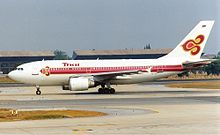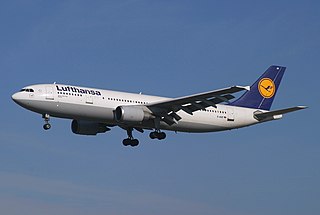
The Airbus A300 is Airbus's first production aircraft and the world's first twin-engine, double-aisle wide-body airliner, developed and manufactured by Airbus from 1971 to 2007.

The Airbus A310 is a wide-body aircraft, designed and manufactured by Airbus Industrie, then a consortium of European aerospace manufacturers. Airbus had identified a demand for an aircraft smaller than the A300, the first twin-jet wide-body. On 7 July 1978, the A310 was launched with orders from Swissair and Lufthansa. On 3 April 1982, the first prototype conducted its maiden flight, and the A310 received its type certificate on 11 March 1983.
Thai Airways International Public Company Limited, trading as THAI is the flag carrier airline of Thailand. Formed in 1961, the airline has its corporate headquarters in Vibhavadi Rangsit Road, Chatuchak district, Bangkok, and primarily operates from Suvarnabhumi Airport. THAI is a founding member of the Star Alliance. The airline is the second-largest shareholder of the low-cost carrier Nok Air with a 15.94 per cent stake (2020), and it launched a regional carrier under the name Thai Smile in the middle of 2012 using new Airbus A320 aircraft. In 2023, it was announced that Thai Smile would be merged back into Thai Airways.
Thai Airways Company or Thai Airways was the domestic flag carrier of Thailand. Its main base was the domestic terminal at Don Mueang International Airport. Its head office was located in Pom Prap Sattru Phai, Bangkok. In 1988, Thai Airways merged to become Thai Airways International.
This is a list of aviation-related events from 1998.
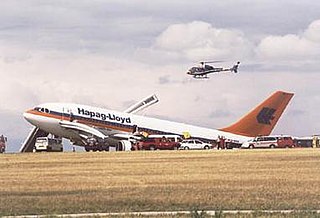
Hapag-Lloyd Flight 3378 (HF-3378) was a passenger service operated by Hapag-Lloyd Flug from Chania, on the island of Crete, Greece, to Hannover, Germany. On 12 July 2000, the aircraft flying the route, an Airbus A310-304, had 143 passengers and 8 crew on board, set off for Hannover leaving the landing gear fully extended, as a precaution, since a malfunction had prevented its proper retraction after take-off. The plane eventually ran out of fuel while attempting a diversion to Vienna, crash-landing just short of runway 34. No fatalities resulted, although the aircraft was written off.

In aviation, pilot error generally refers to an action or decision made by a pilot that is a substantial contributing factor leading to an aviation accident. It also includes a pilot's failure to make a correct decision or take proper action. Errors are intentional actions that fail to achieve their intended outcomes. The Chicago Convention defines the term "accident" as "an occurrence associated with the operation of an aircraft [...] in which [...] a person is fatally or seriously injured [...] except when the injuries are [...] inflicted by other persons." Hence the definition of "pilot error" does not include deliberate crashing.

Tribhuvan International Airport is an international airport located in Kathmandu, Bagmati, Nepal. It has a tabletop runway, a domestic terminal and an international terminal. As the country's main international airport, it connects Nepal to over 40 destinations in 17 countries. The airport is designed in a shape of an airplane when looked from above. The runway extending from the nose to the tail, with the terminal buildings aligned along the fuselage. The distinct shape is visible after takeoff, and while hovering.

Pakistan International Airlines Flight 268 was an Airbus A300, registration AP-BCP, which crashed while approaching Kathmandu's Tribhuvan International Airport on 28 September 1992. All 167 people on board were killed. Flight 268 is the worst crash of Pakistan International Airlines, and the worst ever to occur in Nepal.

Thai Airways Flight 365 was a Thai Airways Company Boeing 737-2P5 with the registration number HS-TBC. On 31 August 1987, the plane crashed during a scheduled flight from Hat Yai International Airport to Phuket International Airport, killing all 83 people on board: 74 passengers and 9 crew. It was the deadliest aviation accident in Thailand at the time, before being surpassed four years later by the crash of Lauda Air Flight 004. Concerned by another aircraft in their vicinity, the crew reduced their approach speed while attempting to land, and failed to recover from an aerodynamic stall. In addition to pilot error, the air traffic controller was blamed for failing to keep Flight 365 and the other aircraft adequately separated.

Garuda Indonesia Flight 152 (GA152/GIA152) was a scheduled domestic flight operated by Garuda Indonesia from Soekarno-Hatta International Airport, Tangerang, to Polonia International Airport, Medan, in Indonesia. On 26 September 1997, the aircraft flying the route crashed into mountainous woodlands near the village of Buah Nabar, Sibolangit, killing all 222 passengers and 12 crew members on board. It is the deadliest aviation disaster in Indonesia's history.

Thai Airways International Flight 261 (TG261/THA261) was a scheduled domestic passenger flight from Bangkok's Don Mueang International Airport to Surat Thani International Airport in Surat Thani, Thailand. The flight was operated by Thai Airways International, the flag carrier of Thailand. On 11 December 1998, the aircraft, an Airbus A310-204 registered in Thailand as HS-TIA, stalled and crashed into a swamp during its landing attempt at Surat Thani Airport. A total of 101 people were killed in the crash.

One-Two-Go Airlines Flight 269 (OG269) was a scheduled domestic passenger flight from Bangkok to Phuket, Thailand. On 16 September 2007, about 15:41 ICT, the McDonnell Douglas MD-82 operating the flight crashed into an embankment beside runway 27 at Phuket International Airport (HKT) bursting into flames upon impact during an attempted go-around after an aborted landing, killing 90 of the 130 people on board. It is the third deadliest aviation incident to occur in Thailand.
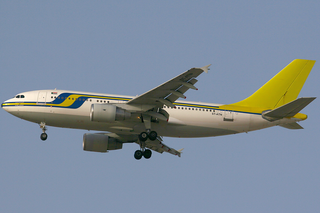
Sudan Airways Flight 109 was a scheduled international Amman–Damascus–Khartoum passenger flight, operated with an Airbus A310 by the flag carrier of Sudan, Sudan Airways. On 10 June 2008, at approximately 17:26 UTC, the Airbus A310 crashed on landing at Khartoum International Airport, killing 30 of the 214 occupants on board.

Yemenia Flight 626 was an Airbus A310-324 twin-engine jet airliner operated by Yemenia that was flying a scheduled international service, from Sana'a in Yemen to Moroni in Comoros, when it crashed on 30 June 2009 at around 1:50 am local time while on approach to Prince Said Ibrahim International Airport, killing all but one of the 153 passengers and crew on board. The sole survivor, 12-year-old girl Bahia Bakari, was found clinging to wreckage after floating in the ocean for thirteen hours. Bakari was discharged from the hospital on 23 July 2009.

Langtang National Park is a national protected area in north-central Nepal. It was established in 1976 as Nepal's first Himalayan national park and the country's fourth protected area. It covers an area of 1,710 km2 (660 sq mi) in the Nuwakot, Rasuwa and Sindhulpalchok Districts of the central Himalayan region. It contains 26 village communities and includes the Langtang valley. In the north and east it is linked with Qomolangma National Nature Preserve in the Tibet Autonomous Region. The eastern and western boundaries follow the Bhote Koshi and the Trishuli river, respectively.
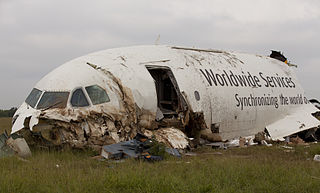
UPS Airlines Flight 1354 (5X1354/UPS1354) was a scheduled cargo flight from Louisville, Kentucky, to Birmingham, Alabama. On August 14, 2013, the Airbus A300 flying the route crashed and burst into flames short of the runway on approach to Birmingham–Shuttlesworth International Airport. Both pilots were pronounced dead at the scene of the crash. They were the only people aboard the aircraft. It was the second fatal air crash for UPS Airlines.
